Key takeaways:
- Cultural appropriation involves borrowing cultural elements without respect or understanding, often leading to commodification of marginalized traditions.
- Cultural identity is essential for fostering a sense of belonging and community, and it shapes personal expression and creativity.
- Examples of cultural appropriation include using traditional attire or symbols without acknowledgment and the fusion of cuisines that neglect original contexts.
- Respectful cultural engagement requires listening, understanding historical significance, and collaborating with community members to honor their traditions authentically.
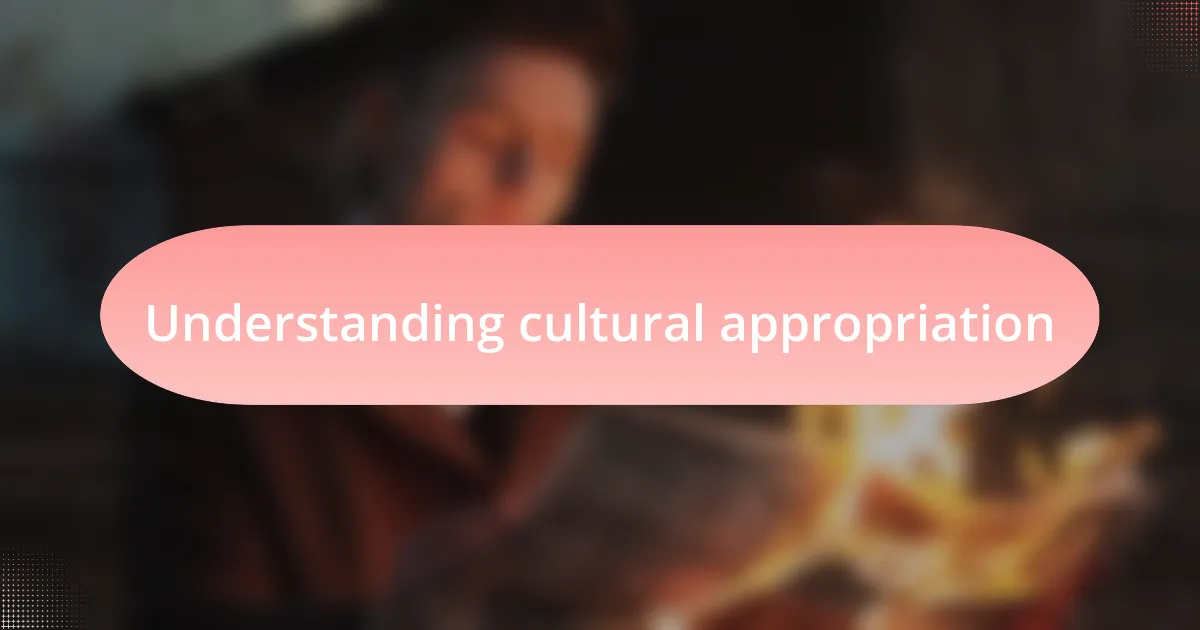
Understanding cultural appropriation
Cultural appropriation is often seen as borrowing elements from another culture without understanding or respecting its significance. I remember a time at a local festival when I saw a group of people wearing traditional attire that represented a culture they didn’t belong to. This moment struck me because it raised a question: When does appreciation turn into appropriation?
The line between cultural appreciation and appropriation can be incredibly thin. For instance, I’ve attended events where music and dance from various cultures were celebrated, yet some performers seemed oblivious to the cultural roots they were drawing from. It made me wonder, are we truly honoring the cultures we showcase, or are we merely taking bits and pieces for our own enjoyment?
Understanding cultural appropriation requires a sensitive awareness of history and power dynamics. It’s essential to ask ourselves who benefits from this exchange. I often reflect on situations where marginalized cultures see their traditions commodified while they themselves continue to face discrimination. This disparity highlights the need for thoughtful engagement with cultures, rather than superficial adoption.
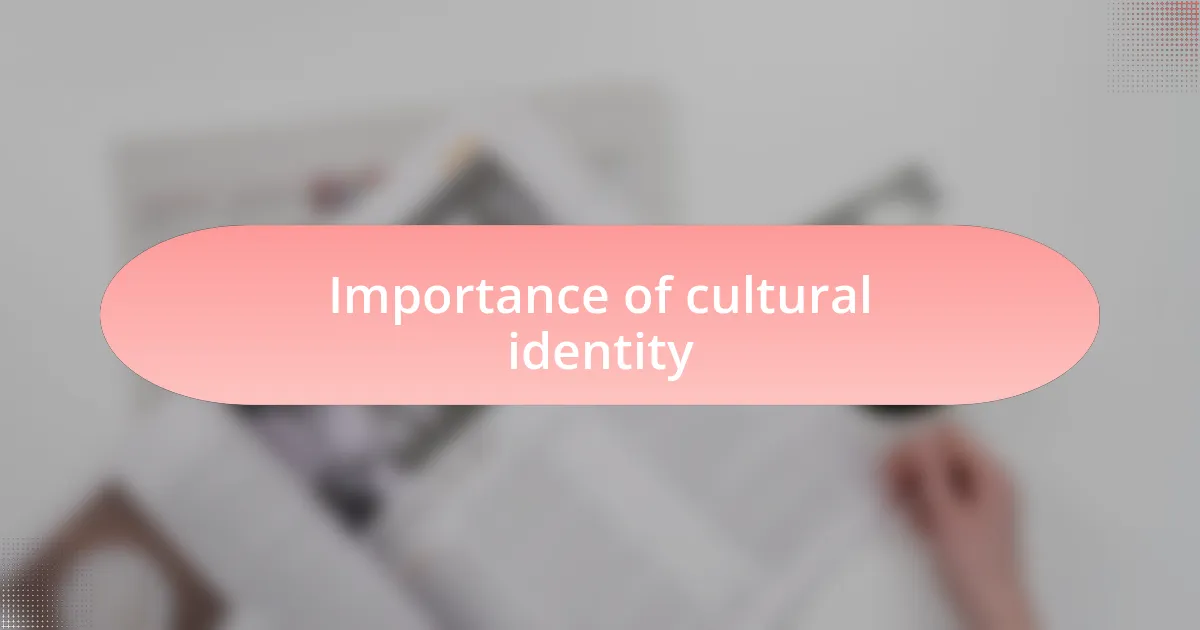
Importance of cultural identity
Cultural identity serves as the backbone of our society, grounding individuals in their heritage and history. I often think about how my own cultural narratives shape my perspectives, influencing everything from my values to my creativity. When we lose touch with our cultural roots, we risk diluting the richness of our identity and the stories that have been passed down through generations.
I’ve found that understanding and embracing cultural identity can foster a sense of belonging and community. At gatherings, I’ve witnessed firsthand how people light up when sharing traditional stories and customs. It’s a profound reminder that our identities, shaped by our cultures, contribute to a broader tapestry of human experience.
Moreover, I frequently ponder the impact of cultural identity on personal expression. When I create art inspired by my heritage, I feel a deep connection to my ancestors. This connection nurtures not just pride, but also a sense of responsibility to honor these traditions. How can we ensure that each cultural identity is celebrated, rather than appropriated? The answer lies in fostering genuine understanding and respect for the unique narratives each culture brings to the table.

Examples of cultural appropriation
Cultural appropriation often manifests in various forms, one notable example being the commercial use of traditional attire without acknowledging its origins. I recall seeing a popular clothing brand launch a collection featuring vibrant prints and patterns reminiscent of African garments, but the campaign lacked any reference to the cultural stories behind those designs. This raises an important question: how can we enjoy fashion without undermining the very cultures that inspire it?
Another instance that strikes me is the adoption of sacred symbols, like the Native American headdress, by individuals at music festivals. I remember attending an event where several attendees proudly donned these headdresses as fashion statements. This left me wondering about the respectful boundaries between admiration and appropriation, and how wearing such items trivializes their profound significance to the cultures they represent.
Food is also a common territory where cultural appropriation occurs. The fusion of traditional dishes with no acknowledgment of their roots can dilute the culinary heritage of a culture. I’ve experienced moments in restaurants where a seemingly exciting “twist” on a classic dish made me reflect on whether the original recipes were celebrated or merely transformed into trendy items for profit. Is it possible to appreciate cultural cuisines while ensuring that their origins are honored and recognized?
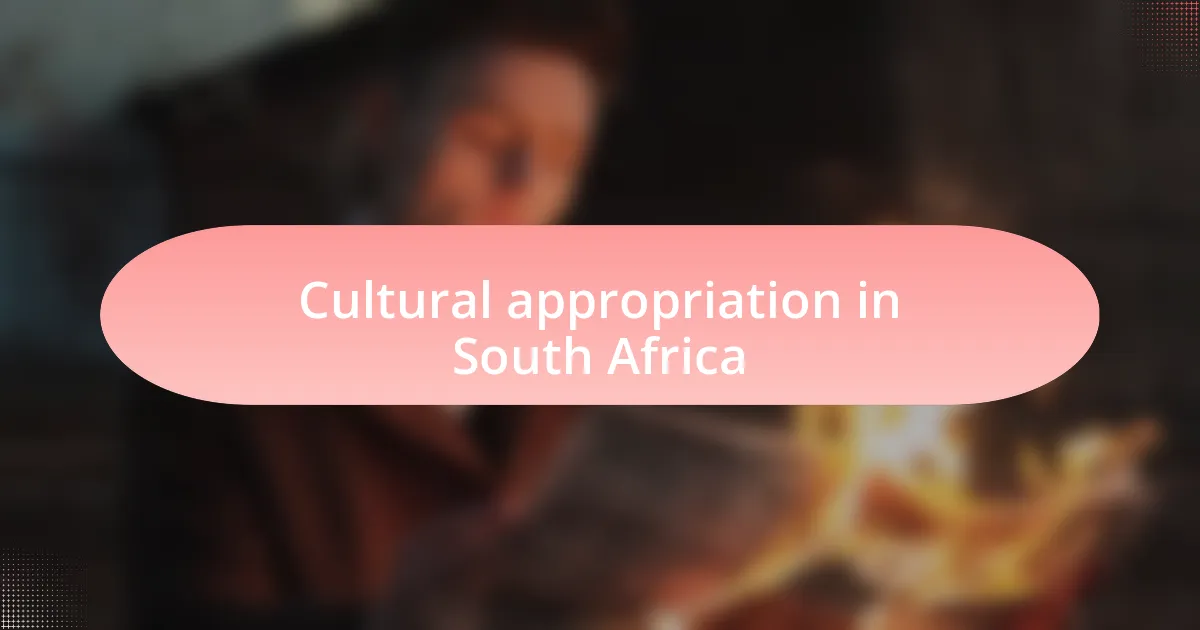
Cultural appropriation in South Africa
Cultural appropriation in South Africa is particularly poignant when examining the landscapes of art and music. I vividly remember attending an art exhibition showcasing talented artists from the townships. While I was inspired by their creativity, it was disheartening to see non-African artists profit from similar themes without any acknowledgment of their origins. How can we truly celebrate artistry without giving credit to those who have nurtured these cultural expressions?
The phenomenon also permeates our culinary scene, reflecting a richer tapestry of cultural exchange. I recall dining at a trendy eatery that proudly advertised its “African-inspired” menu. However, as the dishes arrived, I felt a conflict—were these flavors genuinely respecting their origins, or merely adaptations for a new audience? It sparked a reflection on whether we, as patrons, sometimes allow convenience to overshadow the stories behind these culinary treasures.
Fashion trends further highlight the complexities of cultural appropriation in our society. A dear friend of mine recently showed me a popular magazine featuring models in traditional Xhosa beadwork, but with none of the cultural context provided. It begs the question: what message does this send about ownership and respect? Can we appreciate these beautiful elements without recognizing the heritage and significance they carry?
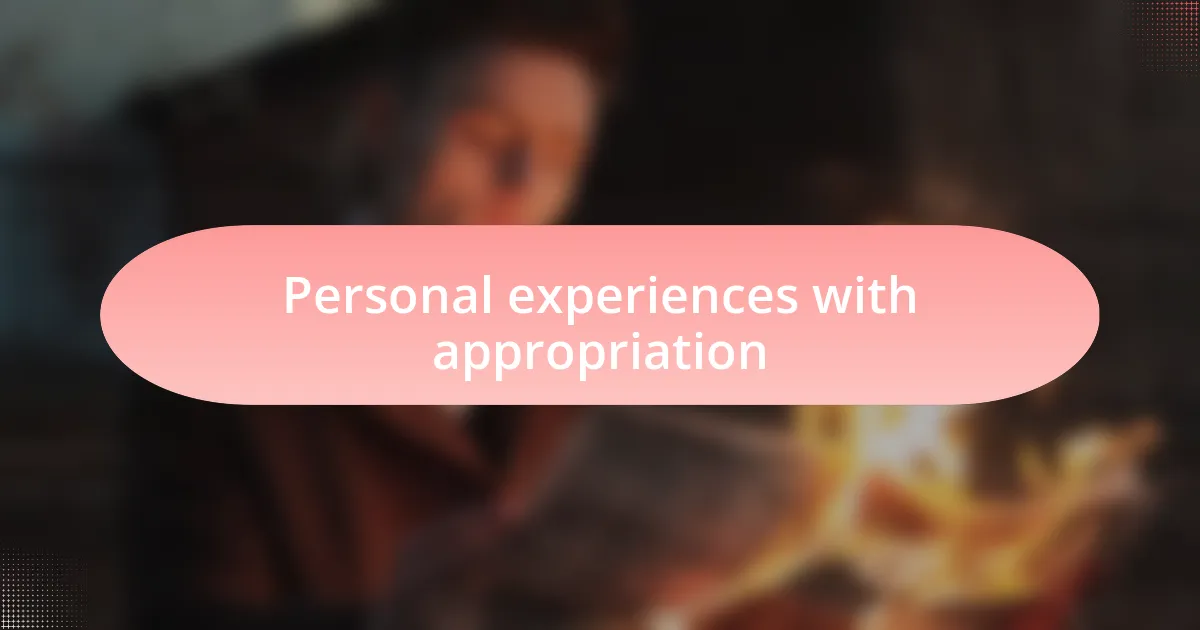
Personal experiences with appropriation
When I reflect on my own experiences, a memory comes to mind from my school days. I remember a classmate who would don traditional attire for our cultural day, yet little did they know about the rich history behind those garments. I often wondered, was it merely a fashion statement, or did they recognize the struggles and triumphs woven into the fabric of those clothes? It left me feeling uncomfortable, as if a precious part of our heritage was being used as a costume rather than celebrated.
Another experience that stands out was during a music festival featuring various artists from diverse backgrounds. I found myself immersed in the vibrant sounds of traditional drumming but was taken aback when I noticed a prominent performer casually borrowing these rhythms without any credit. It made me question the intent behind their performance. Are we truly honoring these musical roots, or merely rebranding them for commercial appeal? This moment reinforced my belief that music is steeped in culture and should be treated with the respect it deserves.
At a local market, I stumbled upon handcrafted jewelry, exquisitely designed by artisans that drew on their heritage. Yet, I couldn’t help but feel a pang of frustration when I observed tourists purchasing replicas from stalls that weren’t honoring the original creators. I ask myself, how do we find a balance between appreciation and appropriation? It disturbs me that these artisans often struggle for recognition while their work is diluted and sold without context. This experience deepened my understanding of the importance of supporting authentic cultural expressions and promoting the voices behind them.
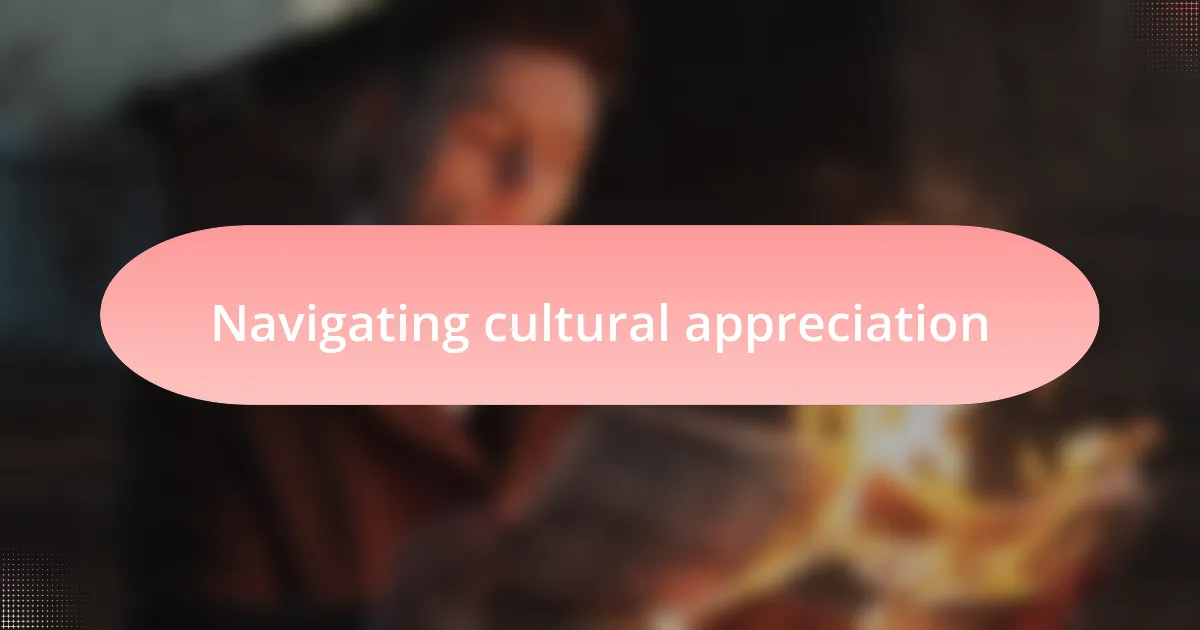
Navigating cultural appreciation
Navigating cultural appreciation can be a delicate dance. I recall attending a cooking class where the chef shared not just recipes but the stories behind the dishes. As I stirred the pot, I felt a connection to the culture—not just through flavor, but through narrative. It made me reflect: how often are we willing to dive deeper and understand the history behind what we enjoy?
There was also a moment during a community art festival when I met an artist whose work embodied her cultural heritage. She spoke passionately about each piece, revealing how they encapsulated her family’s stories and traditions. It struck me then; appreciation requires more than admiration. It demands an openness to engage, learn, and acknowledge the history that shapes these expressions. I often wonder, how can we ensure that our admiration doesn’t drift into misinterpretation?
Moreover, while visiting an exhibition showcasing diverse cultural artifacts, I found myself torn. The pieces, rich in history, sparked a certain pride within me, yet I felt a responsibility to recognize the original contexts of these creations. I asked myself, are we simply spectators in someone else’s narrative, or can we also be allies in preserving the authenticity of their stories? Embracing cultural appreciation means stepping beyond surface-level admiration and actively valuing the voices and histories from which these expressions originate.

Moving towards respectful engagement
Engaging respectfully with different cultures starts with listening. I remember a conversation I had with a friend from the Xhosa community. She shared insights about traditional dress during a celebration. It was not just about the attire’s beauty; each pattern and color told a story. This experience taught me the value of acknowledging the narratives behind cultural symbols rather than just admiring them from a distance.
It’s crucial to approach cultural practices with humility. Last year, I attended a local music festival featuring various cultural performances. As I watched a traditional dance, I felt a surge of energy and joy. Yet, I also realized that appreciating the performance meant understanding the rituals and significance behind it. It made me think: how can we participate in these celebrations without overshadowing the very traditions that entertain us?
Moreover, I believe fostering respectful engagement means seeking permission and guidance when showcasing a culture. I participated in a charity event where we aimed to celebrate local cuisine. Before anything was served, we took the time to consult with community leaders to ensure we honored their practices authentically. This collaboration not only enriched our event but also reinforced the idea that cultural engagement is a partnership, not a takeover. What strategies have you found effective in ensuring mutual respect in cultural exchanges?